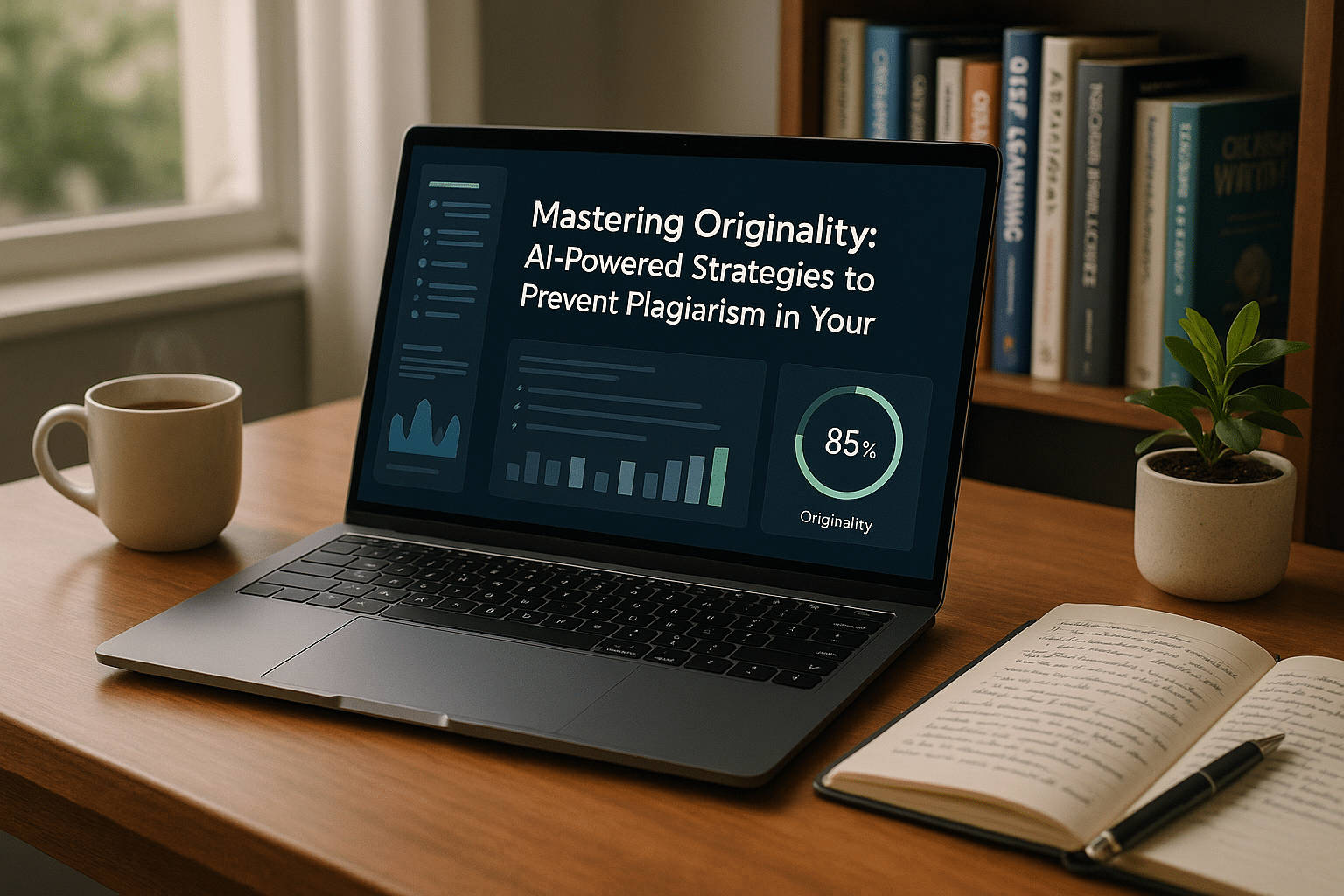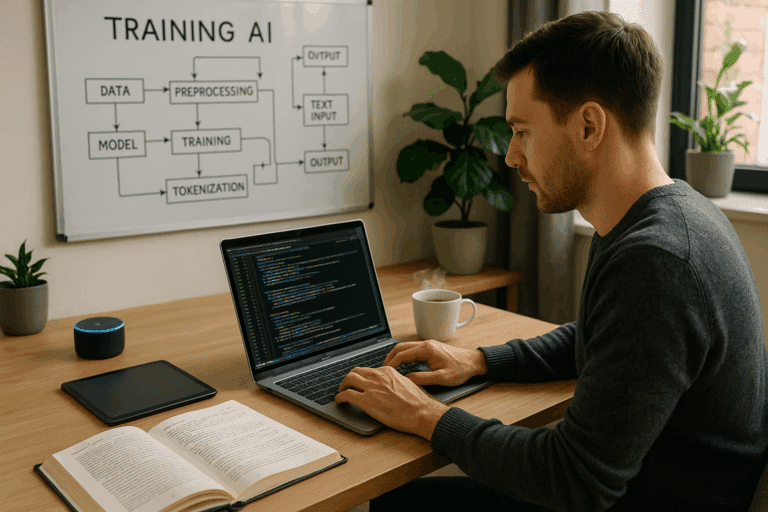Whether it’s accidental or intentional, the result is the same: an utter lack of originality and a significant dent in your reputation. Yet, in our digital age, where content is churned out at lightning speed, how do we ensure our writing remains fresh, innovative, and plagiarism-free? 🤔 The answer lies in Artificial Intelligence.
Indeed, the integration of AI into our writing processes is no longer a distant futuristic concept but an existing reality that offers a plethora of benefits. From checking grammar and spelling to enhancing readability, AI has dramatically reshaped the landscape of content creation. But did you know that AI can also be your invaluable ally in combating plagiarism? Yes, that’s correct! 🎯
AI-Powered Plagiarism Checkers: Your New Best Friend
Imagine having a tireless assistant working around the clock, sifting through billions of web pages, academic papers, and books, comparing your written content against them to ensure its uniqueness. Sounds impressive, doesn’t it? That’s precisely what AI-powered plagiarism checkers do. They utilize advanced algorithms and machine learning techniques to detect any matching phrases or sentences, ensuring your content is 100% original and plagiarism-free.
However, these smart tools go beyond mere plagiarism detection. They also offer feedback on how to improve your writing and prevent plagiarism in the future. By analyzing your writing style and common patterns, these AI-powered tools can provide invaluable insights into how you can enhance your writing originality. It’s like having a personal writing coach at your disposal, providing real-time feedback and advice! ✨
Unleashing Creativity with AI: Beyond Plagiarism Detection
But AI’s role in enhancing writing originality doesn’t stop at plagiarism detection. In fact, it goes much deeper. Think about it – wouldn’t it be great if, instead of just identifying and rectifying plagiarism, we could prevent it from occurring in the first place? Well, that’s exactly where AI comes in, and it’s pretty exciting! 😃
AI-powered writing assistants, such as AI-based paraphrasing tools, can help you avoid plagiarism by transforming your copied content into unique, original text. These tools are smart enough to understand the context, retain the original meaning, and rephrase the text in a way that it becomes completely original. It’s like having your personal wordsmith, ready to spin your words into unique content!
Moreover, AI can also enhance your creativity and originality by suggesting new ideas and diverse ways to express your thoughts. By analyzing millions of data points, AI can predict what content will resonate with your audience, giving you a competitive edge and making your writing more engaging and original.
Coming Up Next: Mastering Originality with AI
In this comprehensive guide, we’ll delve deeper into the fascinating world of AI and its impact on enhancing writing originality. We’ll explore various AI-powered strategies to prevent plagiarism, discuss how these tools work, and reveal some of the best AI tools available in the market. So, whether you’re a seasoned writer or just starting, this guide is your one-stop resource for mastering originality in your writing with the help of AI. So, buckle up, and let’s dive in! 💡
Embracing the Era of AI: Elevating Your Writing Authenticity
Artificial Intelligence (AI) is transforming almost every industry, and writing is no exception. From AI-generated text to plagiarism checkers, AI-powered tools are becoming essential in preserving the originality of our work. But how do these tools work, and how can they help you improve your writing? Let’s dive in and explore. 🧐
Before we dive into the details, you might want to watch this engaging video by the channel “Two Minute Papers” titled “OpenAI’s GPT-3 Language Model Explained“. It offers a comprehensive explanation of how AI models like GPT-3 can generate human-like text.
As you navigate through this article, remember that understanding and using these AI-powered tools effectively is the key to enhancing the originality of your writing. The technology is here to help us, but it is our responsibility to use it wisely and ethically.💡
Understanding AI’s Role in Text Generation
AI algorithms like OpenAI’s GPT-3 and Google’s BERT are capable of generating text that closely mimics human language patterns. These AI models are trained on vast amounts of data and use patterns in this data to predict the next word in a sentence, thereby generating coherent and contextually relevant text.
However, the text generated by AI lacks originality as it is based on pre-existing data. Although the AI can create grammatically correct and contextually appropriate text, it does not have the ability to generate truly original content. Instead, it remixes and rephrases the data it has been trained on. This is an important distinction to keep in mind when using AI for writing.
Nonetheless, AI can still be a valuable tool for writers. For instance, AI text generators can be used for brainstorming ideas, writing first drafts, or even generating content for less important sections of a piece. Using AI in these ways can save time and effort, allowing writers to focus more on enhancing the originality and creativity of their work.
Unveiling the Power of AI in Plagiarism Detection
AI-powered plagiarism checkers have become a fundamental tool for writers, students, and educators alike. These tools can scan vast amounts of text in seconds and detect patterns of plagiarism that might be missed by human reviewers.
AI plagiarism checkers like Turnitin, Grammarly, and Copyscape use advanced algorithms to compare a piece of text against millions of web pages, academic papers, and other digital content. They can detect exact matches, paraphrased content, and even translated plagiarism. By using these tools, you can ensure the originality of your writing and avoid unintended plagiarism.🔍
However, it’s essential to remember that these tools are not infallible. They might sometimes flag non-plagiarized content as plagiarized, or miss instances of subtle plagiarism. Therefore, they should be used as a guide rather than a final authority on plagiarism.
Adopting AI-Powered Strategies for Plagiarism-Free Writing
Now that we understand how AI can generate text and detect plagiarism, let’s explore some strategies for using AI to prevent plagiarism and improve the originality of your writing.
Firstly, use AI text generators wisely. While these tools can be helpful for generating ideas or drafts, avoid using their output verbatim. Instead, use it as a starting point and build upon it with your original ideas and insights.
Secondly, make frequent use of AI-powered plagiarism checkers. These tools can help you identify any unintentional plagiarism in your writing and rectify it before publication. Also, they can help you understand the types of phrases or sentences that are often flagged as plagiarized, helping you avoid them in the future.
Finally, use AI tools for paraphrasing. Tools like Quillbot can help you rephrase your writing, thereby avoiding plagiarism while maintaining the original meaning of the text. However, be careful not to overuse these tools as they can sometimes lead to awkward or unnatural phrasing.
By integrating these strategies into your writing process, you can leverage the power of AI to improve the originality of your work. 🚀
AI vs. Human Writers: A Comparative Analysis
The rise of AI in writing has sparked debates about the role of human writers. Can AI replace human writers? How does the quality and originality of AI-generated text compare to human-written text? Let’s explore these questions through a comparative analysis.
| Parameter | AI Writers | Human Writers |
|---|---|---|
| Originality | Lacks true originality as text is generated based on pre-existing data. | Capable of producing truly original content based on unique ideas and experiences. |
| Quality | Can produce high-quality text in terms of grammar and context relevance. | Quality can vary based on writer’s skill and knowledge. |
| Efficiency | Can generate text quickly and at scale. | Writing process can be time-consuming. |
| Creativity | Struggles to generate creative and nuanced text. | Capable of producing creative and nuanced text. |
As you can see from the table above, while AI can generate high-quality and efficient text, it lacks the originality and creativity of human-written text. Thus, human writers still play a crucial role in creating truly original and creative content. AI tools can be used to support and enhance human writing, but they cannot replace it. 🖋️
Final Thoughts
Artificial Intelligence is revolutionizing the field of writing, offering tools and strategies to enhance the originality of our work. However, while AI can mimic human language patterns, generate text, and detect plagiarism, it cannot replicate the unique ideas and creativity of a human writer.
Therefore, as writers, our task is to use AI as a tool to support our writing process, not as a replacement for our creativity and originality. By doing so, we can leverage the power of AI while preserving the authenticity of our work. After all, it is our unique ideas and perspectives that truly make our writing original.✨
For more insights into how AI is transforming writing, I recommend watching “The Future of AI in Writing” by the channel “Wall Street Journal”. It offers an intriguing glimpse into the future of AI in the writing industry.

Conclusion
In conclusion, the ability to navigate, understand, and utilize technological advancements in both Information Technology (IT) and engineering is a prerequisite in today’s digital age. From the significance of effective database management to the importance of comprehensive cybersecurity measures, we’ve traversed the wide spectrum of modern-day tech necessities in this article.
In terms of software development, we discussed the relevance of agile methodologies and DevOps practices, highlighting the need for swift, efficient, and cohesive teamwork in creating and maintaining software products. We’ve noted the benefits of these methodologies – enhanced productivity, improved client satisfaction, and quicker turnaround times.
We’ve also dug deep into the realm of AI, exploring the transformative impact of machine learning and data analytics on businesses and industries across the board. Remember, AI isn’t about replacing human expertise but augmenting it. Through predictive analytics and deep learning models, AI can provide valuable insights, optimize processes, and drive innovation.
Moreover, we’ve underscored the vital role of cybersecurity in protecting data integrity and privacy. With cyber threats becoming more sophisticated, companies need to remain proactive in mitigating risks and ensuring security compliance.
Lastly, we touched upon cloud computing, a field that has revolutionized the way we store, manage, and access data. We’ve highlighted its cost-effectiveness, scalability, and accessibility as compelling reasons for businesses to transition to the cloud.
In essence, whether you’re a seasoned tech professional or an enthusiast seeking to gain a solid understanding of IT and engineering, it’s crucial to stay abreast of current trends and developments.
As we move forward, we anticipate these technologies to continue evolving, bringing about new challenges but also fresh opportunities for businesses and individuals alike. So, make sure to keep learning, adapting, and innovating. The future of technology is in your hands!
Please feel free to comment and share your thoughts, experiences, or questions regarding the topics we’ve covered. Remember, your contribution helps create a more vibrant and insightful discussion. 😊
Additionally, if you found this article helpful, consider sharing it with your network. Let’s collectively work towards a more technologically savvy society! 🚀
For further reading, refer to IBM’s comprehensive guide on cloud computing, Cisco’s cybersecurity resources, and this detailed analysis of AI on ScienceDirect.
As always, continue learning, continue growing. The future of technology waits for no one! 🌐
References:



